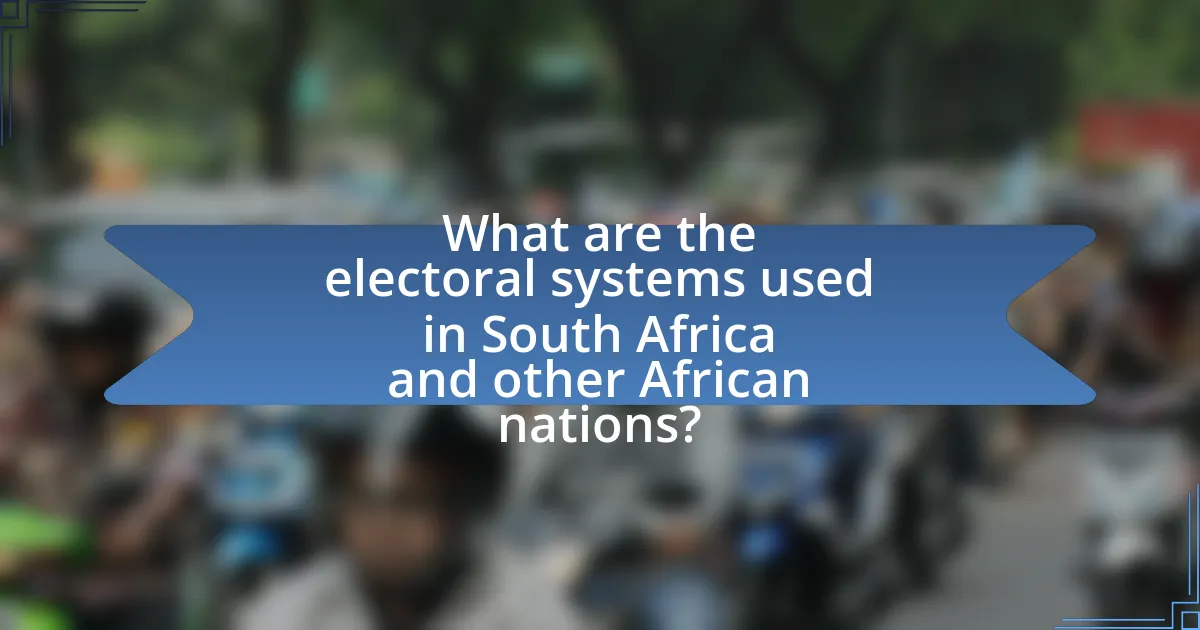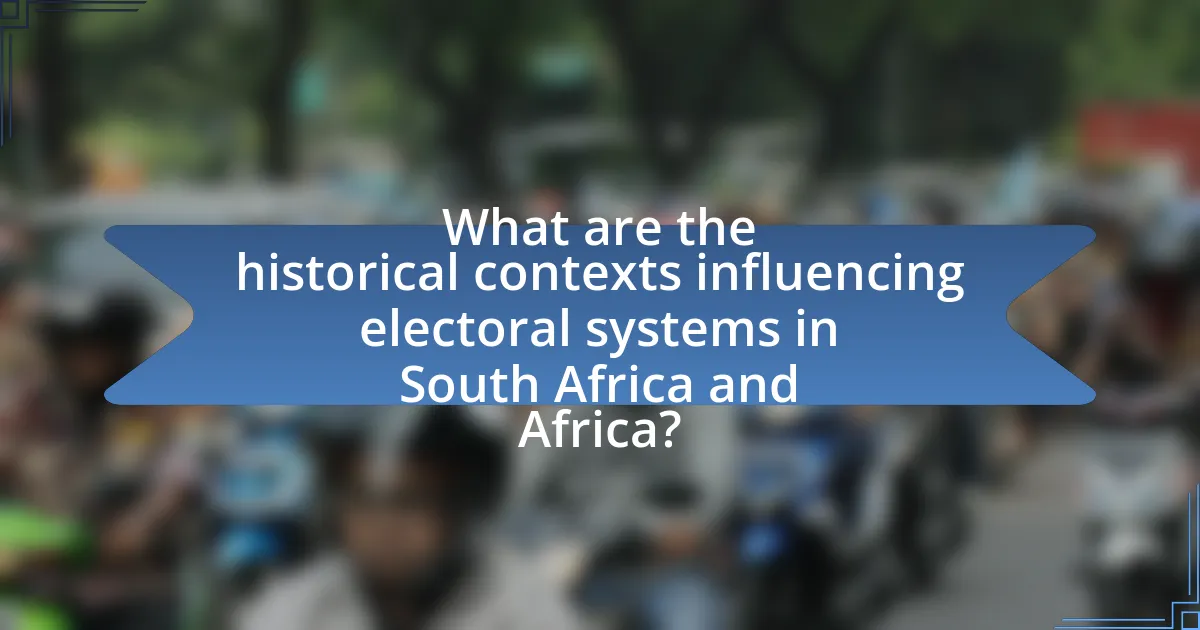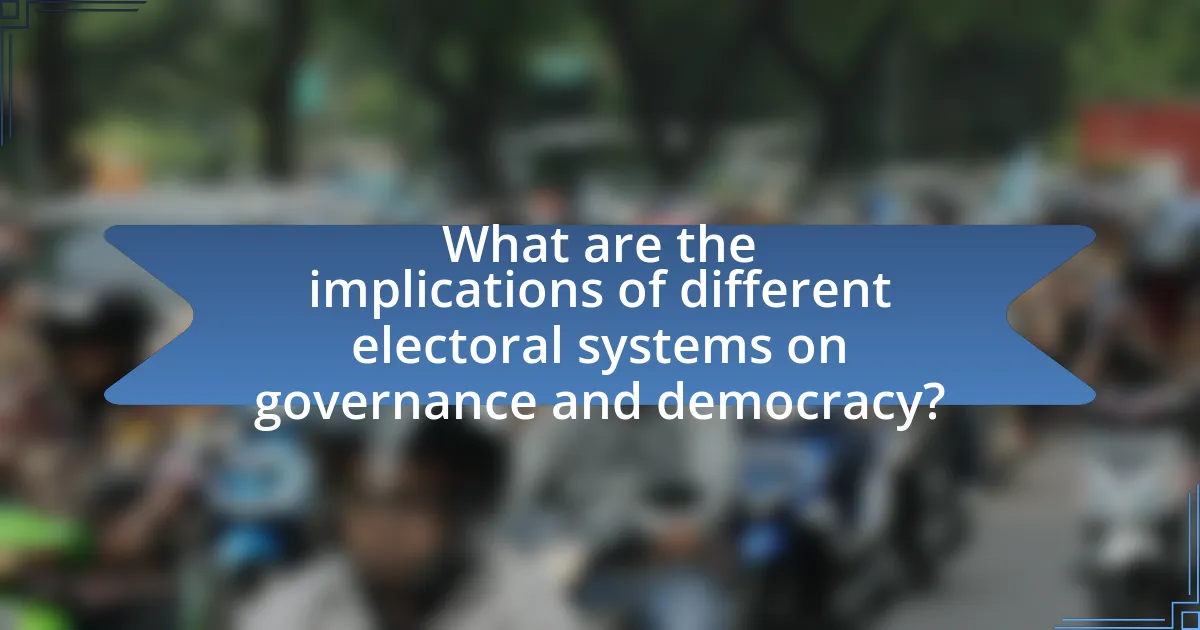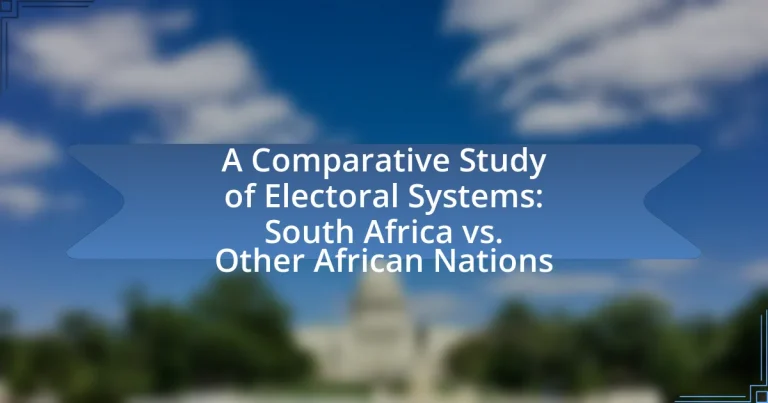The article provides a comparative analysis of electoral systems in South Africa and other African nations, highlighting the use of proportional representation in South Africa’s party-list system, which allows for political parties to gain seats in the National Assembly based on the percentage of votes received. It contrasts this with various electoral frameworks employed across the continent, such as Nigeria’s mixed system and Ghana’s two-round presidential elections. The discussion includes the historical contexts that have shaped these systems, the implications for governance and democracy, and the challenges faced by different electoral models in promoting inclusive representation and political stability. Additionally, the article examines best practices for improving electoral systems and enhancing democratic participation in South Africa and beyond.

What are the electoral systems used in South Africa and other African nations?
South Africa employs a proportional representation electoral system, specifically the party-list system, where voters cast their ballots for political parties rather than individual candidates. This system ensures that the number of seats a party receives in the National Assembly is proportional to the number of votes it receives, as established by the Electoral Act of 1998.
In contrast, other African nations utilize a variety of electoral systems. For example, Nigeria employs a mixed system combining first-past-the-post for legislative elections and proportional representation for local elections. Kenya uses a similar mixed system, with first-past-the-post for the National Assembly and proportional representation for the Senate. Ghana utilizes a two-round system for presidential elections, requiring a candidate to secure more than 50% of the votes to win outright, or face a runoff.
These systems reflect the diverse political landscapes across the continent, with each country adapting its electoral framework to its unique historical and social contexts.
How does South Africa’s electoral system function?
South Africa’s electoral system functions as a proportional representation system, specifically using a party-list system for national and provincial elections. This means that voters cast their ballots for political parties rather than individual candidates, and seats in the National Assembly and provincial legislatures are allocated to parties in proportion to the number of votes they receive. The system is designed to ensure that the representation in the legislature reflects the diversity of the electorate, allowing for a more inclusive political landscape. In the 2019 national elections, for instance, the African National Congress received 57.5% of the votes, securing 230 out of 400 seats in the National Assembly, demonstrating the proportional nature of the system.
What are the key features of South Africa’s electoral system?
South Africa’s electoral system is characterized by a proportional representation model, which ensures that political parties gain seats in the National Assembly in proportion to the number of votes they receive. This system is implemented through a closed-list voting mechanism, where voters select a party rather than individual candidates, and the parties then allocate seats based on their pre-determined lists. The electoral process is overseen by the Electoral Commission of South Africa, which ensures free and fair elections, a principle enshrined in the country’s Constitution. Additionally, South Africa employs a mixed-member proportional representation system for provincial legislatures, further enhancing representation. The first democratic elections were held in 1994, marking a significant transition from apartheid to a multi-party democracy, which solidified the importance of inclusivity and representation in the electoral framework.
How does the proportional representation model work in South Africa?
The proportional representation model in South Africa allocates seats in the National Assembly based on the percentage of votes each political party receives in national elections. This system ensures that smaller parties have a fair chance of representation, as the total number of votes translates directly into the number of seats, rather than a winner-takes-all approach. For instance, in the 2019 elections, the African National Congress received 57.5% of the votes, resulting in 230 out of 400 seats, while smaller parties like the Economic Freedom Fighters, with 10.8% of the votes, secured 44 seats. This model promotes a multiparty system and reflects the diverse political landscape of the country.
What electoral systems are prevalent in other African nations?
Proportional representation and first-past-the-post are prevalent electoral systems in various African nations. For instance, countries like Nigeria and Kenya utilize the first-past-the-post system for their presidential elections, where the candidate with the most votes wins, regardless of whether they achieve an absolute majority. In contrast, South Africa employs a proportional representation system, which allocates seats in the National Assembly based on the percentage of votes each party receives, ensuring a more representative outcome. This distinction highlights the diversity of electoral systems across the continent, with many nations adopting variations of these two primary models to suit their political contexts.
Which countries utilize first-past-the-post systems in Africa?
The countries in Africa that utilize first-past-the-post electoral systems are Botswana, Ghana, and South Africa. These nations employ this voting method for their parliamentary elections, where the candidate with the most votes in a constituency wins. For instance, South Africa adopted the first-past-the-post system in its 1994 elections, reflecting a significant shift in its democratic process post-apartheid.
How do mixed electoral systems operate in various African contexts?
Mixed electoral systems in various African contexts operate by combining elements of both proportional representation and first-past-the-post voting, allowing for a more inclusive representation of diverse political interests. For instance, South Africa employs a proportional representation system for its National Assembly, which ensures that smaller parties can gain seats in parliament, reflecting the country’s multi-ethnic society. In contrast, countries like Namibia and Lesotho utilize mixed-member proportional systems, where voters cast two ballots—one for a candidate and another for a party—resulting in a blend of local representation and proportionality. This approach aims to balance the need for stable governance with the representation of minority groups, as seen in the 2019 elections in Lesotho, where the mixed system facilitated a more equitable distribution of parliamentary seats among various political parties.

What are the historical contexts influencing electoral systems in South Africa and Africa?
The historical contexts influencing electoral systems in South Africa and Africa include colonial legacies, apartheid, and post-colonial governance structures. Colonial rule established systems that often excluded indigenous populations from political participation, leading to a lack of representative governance. In South Africa, the apartheid regime enforced racial segregation and disenfranchisement, which shaped the current electoral framework post-1994, emphasizing universal suffrage and proportional representation. Across Africa, many nations adopted electoral systems influenced by their colonial pasts, often reflecting the need for stability and control rather than true democratic representation. For instance, countries like Kenya and Nigeria have experienced electoral violence and manipulation, rooted in historical ethnic divisions exacerbated by colonial policies. These contexts collectively inform the design and functionality of electoral systems across the continent.
How has South Africa’s history shaped its electoral system?
South Africa’s history has profoundly shaped its electoral system, particularly through the legacy of apartheid and the transition to democracy. The apartheid regime, which enforced racial segregation and disenfranchised the majority black population, necessitated a complete overhaul of the electoral framework post-1994. The introduction of a proportional representation system aimed to ensure that all racial and ethnic groups could participate in governance, reflecting the country’s diverse demographics. This system was designed to prevent the dominance of any single group, a direct response to the historical exclusion experienced under apartheid. The 1996 Constitution further solidified these changes by enshrining the right to vote for all citizens, establishing an independent Electoral Commission, and promoting free and fair elections. These historical contexts underscore the evolution of South Africa’s electoral system as a mechanism for inclusivity and representation, contrasting sharply with the electoral practices in many other African nations that may still grapple with issues of exclusion and authoritarianism.
What role did apartheid play in the development of South Africa’s electoral framework?
Apartheid significantly shaped South Africa’s electoral framework by institutionalizing racial segregation and disenfranchisement. Under apartheid, which lasted from 1948 to the early 1990s, the electoral system was designed to favor the white minority, systematically excluding non-white populations from voting and political participation. This exclusion was codified through laws such as the Natives Representation Act of 1936, which limited black South Africans’ voting rights to a few representatives in a separate parliamentary chamber. The apartheid regime’s electoral framework was characterized by a lack of democratic principles, as it enforced a system where only white citizens could vote in national elections, thereby entrenching racial inequalities. The dismantling of apartheid in the early 1990s led to the establishment of a new, inclusive electoral framework, culminating in the first multiracial elections in 1994, which marked a significant shift towards democracy and equal representation for all South Africans.
How have post-apartheid reforms impacted electoral processes in South Africa?
Post-apartheid reforms have significantly transformed electoral processes in South Africa by establishing a more inclusive and democratic framework. The introduction of the Electoral Act of 1998, which aimed to ensure free and fair elections, mandated the establishment of the Electoral Commission of South Africa (IEC) to oversee elections and maintain electoral integrity. This reform has led to increased voter participation, with the 1994 elections witnessing a voter turnout of 86%, reflecting the public’s engagement in the democratic process. Additionally, the implementation of proportional representation has allowed for a more diverse representation of political parties in the National Assembly, enhancing the pluralistic nature of South African democracy. These reforms have collectively strengthened the legitimacy of electoral outcomes and fostered a culture of accountability within the political system.
What historical factors have influenced electoral systems in other African nations?
Colonialism and post-colonial governance have significantly influenced electoral systems in various African nations. The legacy of colonial rule often established centralized power structures that persisted after independence, impacting how elections are conducted. For instance, countries like Kenya and Nigeria adopted electoral frameworks that mirrored their colonial administrations, leading to a focus on majoritarian systems that often marginalize minority groups. Additionally, the struggle for independence in many nations fostered a political culture that prioritized party loyalty over democratic processes, as seen in Zimbabwe and Tanzania, where dominant parties have maintained control through electoral manipulation. These historical contexts shape the current electoral landscape, often resulting in systems that reflect past injustices and power dynamics rather than equitable representation.
How did colonialism affect electoral practices in Africa?
Colonialism significantly altered electoral practices in Africa by imposing foreign governance structures that often excluded indigenous populations from political participation. For instance, during the colonial period, many African nations were governed by European powers that implemented systems favoring a small elite, typically composed of colonial administrators and local collaborators, while disenfranchising the majority of the population. This exclusion was evident in countries like Kenya and South Africa, where electoral systems were designed to maintain colonial control and suppress the voices of the native populace. The introduction of indirect rule in some regions further entrenched these practices, as local chiefs were co-opted to enforce colonial policies without genuine representation for their communities. Consequently, the legacy of colonialism has had lasting effects on the political landscape of Africa, leading to ongoing challenges in establishing inclusive and representative electoral systems post-independence.
What are the legacies of independence movements on current electoral systems?
The legacies of independence movements on current electoral systems include the establishment of democratic frameworks and the promotion of political pluralism. Many African nations, including South Africa, adopted electoral systems that reflect the aspirations for self-determination and representation following their independence. For instance, South Africa’s transition from apartheid to a democratic system in 1994 was influenced by the anti-colonial struggles, leading to a proportional representation system designed to ensure diverse political representation. This legacy is evident in the electoral systems of other African nations, where independence movements often resulted in the adoption of multi-party systems aimed at preventing the dominance of a single political entity, thereby fostering competition and accountability.

What are the implications of different electoral systems on governance and democracy?
Different electoral systems significantly impact governance and democracy by shaping political representation, party systems, and voter engagement. For instance, proportional representation often leads to multi-party systems, enhancing representation for diverse groups, while first-past-the-post systems can result in a two-party dominance, marginalizing smaller parties. Research indicates that countries with proportional representation, such as South Africa, tend to have higher voter turnout and more inclusive governance compared to those using majoritarian systems, which can foster disenfranchisement. Additionally, the electoral system influences policy stability; proportional systems may lead to coalition governments that require compromise, while majoritarian systems can produce decisive governance but risk alienating minority voices. These dynamics illustrate how electoral systems are crucial in determining the quality and inclusiveness of democratic governance.
How does South Africa’s electoral system impact political representation?
South Africa’s electoral system, which employs a proportional representation model, significantly enhances political representation by allowing a diverse range of parties to gain seats in the National Assembly based on their share of the vote. This system ensures that smaller parties, including those representing minority groups, can secure representation, thereby reflecting the country’s multicultural society. For instance, in the 2019 national elections, the African National Congress received 57.5% of the votes, while smaller parties like the Economic Freedom Fighters and the Democratic Alliance also gained substantial representation, illustrating the system’s capacity to accommodate various political voices. This proportional approach contrasts with majoritarian systems used in other African nations, where dominant parties often monopolize power, leading to underrepresentation of minority interests.
What are the advantages and disadvantages of proportional representation in South Africa?
Proportional representation in South Africa has the advantage of ensuring that political parties receive seats in the legislature that reflect their share of the vote, promoting a more inclusive political landscape. This system allows for a greater diversity of voices and perspectives in governance, as evidenced by the representation of smaller parties in the National Assembly, which can lead to more comprehensive policy discussions.
However, the disadvantages include the potential for fragmented legislatures, where numerous parties may make it difficult to form stable governments. This fragmentation can lead to coalition governments that may struggle to achieve consensus, as seen in instances where parties with divergent interests must negotiate to pass legislation. Additionally, the reliance on party lists can diminish the accountability of individual representatives to their constituents, as voters may feel disconnected from the decision-making process.
How does voter turnout in South Africa compare to other African nations?
Voter turnout in South Africa is generally higher than in many other African nations. For instance, the voter turnout for the 2019 national elections in South Africa was approximately 65%, which is significantly above the average turnout of around 50% for other African countries during the same period. Countries like Nigeria and Kenya reported voter turnouts of about 35% and 78%, respectively, highlighting the variability across the continent. This data indicates that while South Africa’s turnout is robust compared to some nations, it is comparable to others like Kenya, which has a higher turnout.
What effects do various electoral systems have on governance in other African countries?
Various electoral systems significantly influence governance in African countries by shaping political representation, party dynamics, and policy outcomes. For instance, proportional representation systems, like those in South Africa and Namibia, tend to promote multi-party systems, leading to more inclusive governance but also potential fragmentation and coalition challenges. In contrast, majoritarian systems, such as those in Kenya and Nigeria, often result in a two-party dominance, which can streamline decision-making but may marginalize smaller parties and ethnic groups. Evidence from the African Union’s 2020 report indicates that countries with proportional representation have higher voter turnout and greater representation of women in parliament, demonstrating a correlation between electoral systems and governance quality.
How do electoral systems influence party systems and political stability?
Electoral systems significantly influence party systems and political stability by determining how votes translate into seats and shaping the competitive landscape for political parties. For instance, proportional representation systems tend to encourage multi-party systems, as seen in South Africa, where the African National Congress, Democratic Alliance, and Economic Freedom Fighters coexist, leading to a more fragmented political environment. In contrast, majoritarian systems, like those in many other African nations, often result in fewer dominant parties, which can enhance political stability by reducing fragmentation and facilitating clearer governance. Historical evidence shows that countries with stable electoral systems, such as Botswana, maintain political stability and effective governance, while those with less stable systems, like Zimbabwe, experience political turmoil and conflict. Thus, the design of electoral systems plays a crucial role in shaping the dynamics of party systems and the overall stability of political environments.
What challenges do different electoral systems pose for democratic governance in Africa?
Different electoral systems in Africa pose significant challenges for democratic governance, including issues of representation, electoral integrity, and political stability. For instance, winner-takes-all systems can marginalize minority groups, leading to disenfranchisement and social unrest, as seen in countries like Kenya during the 2007 elections. Proportional representation systems, while promoting inclusivity, can result in fragmented parliaments that complicate coalition-building and governance, as evidenced in South Africa’s post-apartheid political landscape. Additionally, the prevalence of electoral fraud and manipulation undermines public trust in democratic processes, with reports from organizations like the African Union highlighting irregularities in elections across various nations. These challenges collectively hinder the effectiveness and legitimacy of democratic governance in Africa.
What best practices can be adopted for improving electoral systems in Africa?
To improve electoral systems in Africa, adopting practices such as enhancing transparency, implementing independent electoral commissions, and utilizing technology for voter registration and results transmission is essential. Transparency can be achieved through open access to electoral processes and data, which builds public trust and accountability. Independent electoral commissions, free from political interference, ensure fair administration of elections, as evidenced by successful models in countries like Ghana. Additionally, the use of technology, such as biometric voter registration and electronic voting systems, has been shown to reduce fraud and increase efficiency, as demonstrated in Kenya’s 2017 elections. These best practices collectively contribute to more credible and participatory electoral processes across the continent.
How can electoral reforms enhance democratic participation in South Africa?
Electoral reforms can enhance democratic participation in South Africa by increasing voter accessibility and ensuring fair representation. For instance, implementing proportional representation can allow smaller parties to gain seats in the legislature, reflecting a broader spectrum of public opinion. According to the Electoral Commission of South Africa, reforms such as simplifying voter registration processes and improving the accessibility of polling stations have led to increased voter turnout, which rose from 73% in the 2014 elections to 76% in 2019. These changes demonstrate that targeted electoral reforms can effectively engage more citizens in the democratic process, fostering a more inclusive political environment.
What lessons can be learned from successful electoral systems in other African nations?
Successful electoral systems in other African nations demonstrate the importance of inclusivity, transparency, and robust legal frameworks. For instance, countries like Ghana and Botswana have implemented systems that encourage broad participation and ensure fair representation, which has led to political stability and public trust in the electoral process. Ghana’s electoral commission operates independently and is known for its transparency, which has resulted in peaceful transitions of power since 1992. Similarly, Botswana’s consistent adherence to democratic principles and regular electoral cycles has fostered a stable political environment. These examples highlight that effective electoral systems prioritize citizen engagement, uphold the rule of law, and maintain institutional integrity, which are crucial for fostering democracy and governance in any nation.


